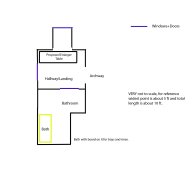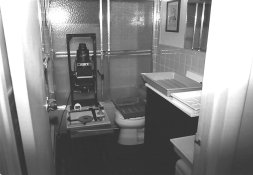I've had two darkrooms in a bathroom with only the toilet and sink. One was under a stairway. That's about as small as it gets.
Worked rather well for 8x10. Maybe that's where I got in the habit of printing small.
In both cases, I made a table to go over the toilet and placed the enlarger, timer, dodging/burning tools, grain focuser on that table. The paper safe went on the seat of the toilet, so that it was handy to the enlarger. I used a Durst 600 enlarger in the bathroom under the stair, and I had room for a D2 in the second bathroom darkroom.
If I recall, I cut a sheet of plywood that went across the sink. One could cover it with sheet vinyl to protect the surface and improve the appearance. I must have had blocks on each corner to raise it just above the height of the sink. This gives enough surface for three 8x10 trays. (D, S, F.) You might consider using a citric acid stop bath in so small a space. Of the three chemicals, it's the stop that gives off the strongest odor, especially that Kodak stuff. (Highly caustic.) I made fresh developer for each session and stored the stop and fixer in appropriately sized containers. These, and other darkroom utensils could be stored in drawers and in the cupboard below the sink. I did not have good temperature control of my developer, and in those days, I didn't care! A Zone VI compensating, developing timer would rectify that. I removed this plywood for developing film. There's usually enough space on either side of the sink for developing tanks, etc.
One nice thing about bathrooms, they usually have fans. If the small bathroom is being used ongoing for a darkroom, one might consider installing a lightproof vent in the door. This would much improve ventilation. (It's hard to exit air, if there's little or none entering the area.)
I hung a single safelight in the center of the ceiling and ran the cord down through open hooks to the plug that all bathrooms have. That way, I could remove the safelight, when I was done. The hooks weren't all that obtrusive, so I left them when the darkroom wasn't in use.
To make the darkroom light-tight, I hung a simple, removable curtain rod well above the door frame outside the darkroom. That worked quite well. The curtain was wide enough to prevent light from entering from the sides, and the black cloth was long enough so that the curtain would sit on the floor a little. I took care to make sure that the cloth was thick enough to prevent light from getting through. If the door opens out to the exterior, one could put the curtain inside the darkroom. Of course, the door was closed when printing or developing film.
After a printing session, I could put all this stuff away in a storage area.


 .
.


